15 April 2003
Part 1
The day starts out as any other. After a steamy walk to the market, we catch a taxi to the shopping center to putter in the air-conditioning for a while. Later we take in a Thai movie with English subtitles. Afterward, the harsh sun has softened. It's an orange ball behind haze of the western mountains. Maybe the day's heat is past, we think. Stepping outside, we realize that relief doesn't come that quickly. In another taxi, we head for home. Driving west, evening vendors are setting up to sell food for evening meals. Fruit peddlers doze sleepily in their chairs. Traffic slows near the art museum. Our driver tries to bypass it but gets blocked again. That’s when it happens.
A pick-up pulls around us into oncoming traffic. The back is loaded with young men, each armed, gun barrels pointed to the sky. Nearing the intersection, the light turns green and they zoom ahead. We watch as they reach the corner, level their weapons and fire. A man on the sidewalk was hit. Others gather around him. The truck is gone before we realize what's happening. Our driver steps on the gas and gets us home...safety. It’s easier to comfort oneself by thinking of such things as isolated events – a freak incident that we just happened to witness. We wonder if it will be written up in the paper or on the evening news.
A new day begins. Thapae Gate is set up for a big event. Again we walk to the market and go there by red truck taxi. Heading east, we pick up passengers near the bank, near the hospital. We reach the west side of the old city and turn north as a truck revs its engine and passes us. This one is full of people too, five young men, a boy, an old man. As we turn, I weapons in the bed of the truck. Another truck passes...this time a family, each person holding a gun. The two of us edge ourselves away from the open windows and hide behind the solid sides of the truck as our hearts begin to pound.
Not the driver makes a left. Armed people stand along the side of the moat. Some talk, others watch and wait. Something is going to happen. Adrenalin rushes through us. We turn right again. We hear a scream, a yell, a loud crash as the spray hits the side of our truck. It's crossfire...not meant for us. We duck and realize it’s begun.
Marauders converge on Thapae Road. A man sells weapons on the sidewalk. Mothers run carrying babies in their arms. Others stand watch, armed, alert. Pacifist or not, there comes a time for every person when the survival instinct kicks into gear. This is our time.
We stop the taxi and make our way to the weapon vendor. Spread out on a plastic tarp are small arms, assault rifles, any size imaginable. We touch one, pick up another. The big ones are menacing, inviting trouble, we think. The small ones are pathetic, totally useless. We settle on one that's middle-sized. “How much?” we ask the vendor. “200,” he replies. We look at each other. “I load for free,” he adds, “no extra charge!” "Ok!"
We hand over the bills to his son as he shows how to load and fire it. Other customers gather round. I tuck the weapon into my shopping bag and we head off down the street. It's clogged now...trucks, cars, motorcycles, people on foot running, ducking, watching. A man stares straight at us. Quickly, we duck into doorway. He moves on to an easier target as we sigh in relief.
Stepping out again, we head east. The road will be more open there. Maybe we will be safe. From the corners of my eye. I see a truck passing near to where we walk. I turn to look at its reflection in a shop window. Distorted by the glass, a young man stands...ready to attack. A chill runs down my spine, in a split second I try to move but it's too late! I'm hit from behind. My whole body shudders from the impact…my skin goes icy cold. The two of us stand shocked, soaked with ice water from head to toe. It’s Songkran, the new Buddhist year.
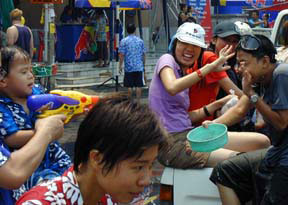
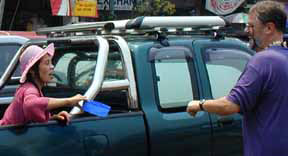
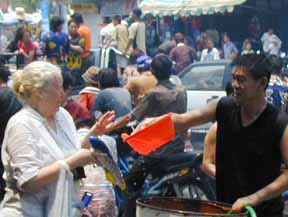 |
Part 2
Geoffrey Walton is well known in this part of the world for writing about Thai customs and culture. His book, A Northern Miscellany, published back in 1989, is still around for interested travelers and expats. He also publishes in Chiangmai tourist magazines and newspapers.
His take on Songkran is that it serves as a great equalizer. In Asian cultures like this, with such a deeply ingrained sense of hierarchy, Songkran is a time when tables turn. Chaos reigns. For three days, the old order disappears. People of low status attack those of high status with impunity. 362 days of pent up tension is acted out in this one great cathartic psycho-drama. Since no one is immune from the pinch of hierarchy, everyone takes part and embraces a gleeful revenge...young and old, rich and poor, foreigners and locals, shop keepers and customers.
Still, in a society that bends over backward to show deference to those of higher rank, Songkran is not a malicious time. For the most part, care is taken with those who clearly resist. Never soaked to the bone, they may, however, receive a few cooling squirts that dampen the shirt or a respectful splashing of hands, a relief it this sweltering season .
The water is, after all, a blessing. It is a time when Buddha figures emerge from 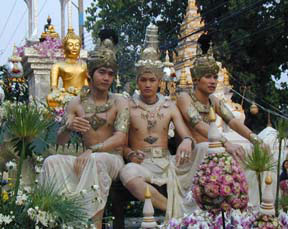 the temples and are carried down streets as both devotees and visitors wash each figure with a dousing of
sweetly scented holy water. Water that collects at the base of each figure, is scooped up in cups or on leafy branches and splashed back over the crowds, much as Catholic priests sprinkle holy water on the faithful.
the temples and are carried down streets as both devotees and visitors wash each figure with a dousing of
sweetly scented holy water. Water that collects at the base of each figure, is scooped up in cups or on leafy branches and splashed back over the crowds, much as Catholic priests sprinkle holy water on the faithful.
We laugh and splash, puddles trailing our steps. Some greet us with an graceful bow, others with a wry smile and twinkling eye that warns of the attack to come. In either case, our response remains the same. “Kopkhun maak ka! Sawatdee bee mai!” (Yes, thank you so much and happy New Year to you too!) along with our own wet retaliation.
Our gun quickly proves inefficient both in range and in distance, not to mention in reloading. We go back to the arms dealer and purchase the less expensive but far more satisfying plastic bucket. At one shop, we give our gun to a girl in exchange for free access to her garden hose. Her smile tells us she thinks it's a fair exchange. Her brother puts a large block of ice into the tub she is filling. Soon, the ammunition will be ready for use…icy cold…what fun!
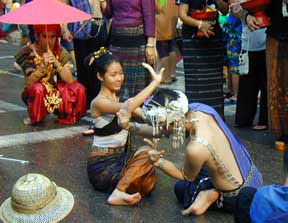 Relentlessly the battles continue. From left and right, our position is pounded. The street is choked with trucks. Steam rises from the ground. There is no quick escape from those
who douse us but no escape for them either. We relish the retaliation. The scene goes on for hours. Photos in our zip-locked camera number in the hundreds. Finally weariness creeps in and we rest on benches at a curbside
café.
Relentlessly the battles continue. From left and right, our position is pounded. The street is choked with trucks. Steam rises from the ground. There is no quick escape from those
who douse us but no escape for them either. We relish the retaliation. The scene goes on for hours. Photos in our zip-locked camera number in the hundreds. Finally weariness creeps in and we rest on benches at a curbside
café.
This simple act removes us from the most furious fighting. Occasional snipers hit us when we are not looking. A young boy fills a large tub with water then scoops out buckets-full to fire at unsuspecting bystanders. A soaked three-year old joins him. With undeveloped motor skills and strength, she's satisfied to soak a pair of pants or two. Her targets look down at her, surprised and smiling. They pour a little water on her shoulders and she runs off with a squeal. Back at the tub, her mother strips her naked and plops her in it for a soak...a duck in a puddle, she smiles.
By afternoon, the cars and trucks and motorcycles thin out. The procession of Buddhas has begun at Narawat Bridge. They reach us on their journey across town to Wat Phra Sing. Exotic flowers and plants surround the floats. High above sits the Buddha...in gold or bronze or white. Men in costumes, women in dress look like ancient Lanna paintings. Drummers pound a deafening sound. Musicians play the strangely eerie music. Dancers in golden head dresses and armbands spin and snake their fingers through the air. The scent of roasting sweet corn rises in the air where bells and banners glitter golden in the breeze. A monk sitting near the Buddha figure and sprinkles water blessings across the crowds below. We receive our blessings too.
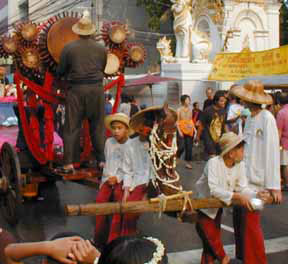 Songkran is an old festival with roots in ancient Hindu history. It marks the end of the dry season (we hope) and the beginning of the rainy one. Crops are in. Field work is finished for
a time. It is now that the Goddess of the Water blesses the world with her mercy. This is the Songkran story, as we understand it:
Songkran is an old festival with roots in ancient Hindu history. It marks the end of the dry season (we hope) and the beginning of the rainy one. Crops are in. Field work is finished for
a time. It is now that the Goddess of the Water blesses the world with her mercy. This is the Songkran story, as we understand it:
Part 3
Long, long ago and far away in the sixth lowest level of heaven there lived a member of the Brahmin race, the 4 -faced creators of the universe. This particular Brahmin was a gifted poet, singer and creator of riddles but his soul was warped and he had a twisted sense of humor.
One day, he heard others talk and sing the praises of a wise and learned mortal man, son of a local merchant. Seized with jealousy, this Brahmin decided to put this mortal to the test. He would put to him a riddle. If the mortal failed to solve the riddle, he would be required to chop off his own head. On the other hand, if the mortal solved the riddle, then the Brahmin would lose his. The challenge was accepted and out of respect for the poor mortal’s courage, the Brahmin gave him seven days to ponder an answer. This was the riddle that was posed:
“Where is the rasee at dawn?”
“Where is the rasee at noon?”
“Where is the rasee at dusk?”
(Rasee is the luminous, glowing quality that beings possess when they are living vibrant healthy lives.)
Immediately, the mortal knew this riddle was beyond him. Worried, he withdrew to one of his father’s seven mansions in the hills to meditate. In search of answers, each day he moved to another mansion, but to no avail.
On the last evening of the seventh day, he went into the cool evening air, placed his mat between two tall sugar palm trees and again began to meditate. Suddenly he was distracted by two eagles in the boughs above. Since part of his learning was the language of birds and other creatures, he listened to the conversation.
The eagle's wife said to her husband, “what a fine young pig you brought for us for supper! And what do you hope to catch tomorrow night?” The eagle husband responded, “Oh, tomorrow will be no problem at all, for the mortal will never answer the Brahmin’s riddle. We shall have his flesh to eat for many days.” “And what is this riddle and it’s answer?” asked the wife, “for I’m sure you must know, since your wisdom is far greater than that of mere mortals!” “Indeed, it is!” replied the husband, and he answered her question as the mortal listened below.
The next morning crowds gathered. The Brahmin tried to hide his gleeful anticipation, for superiority would surely be his! Calmly, the mortal entered. One at a time, the Brahmin again posed the questions:
“Where is the rasee at dawn?”
“At dawn, it shines from the face, which is why we bathe our face on rising,” the mortal answered.
The Brahmin’s face darkened as he asked the second question: “And where is the rasee at noon?”
“At noon it is in our body, which is why we bathe at noon and sprinkle ourselves with scented water throughout the day,” came the answer.
Now deeply troubled, the Brahmin asked the final question: “Then where is the rasee at dusk?” “At dusk, it is in the feet, which is why we bathe our feet on entering the house as darkness falls.” There was great silence. The four faces of the Brahmin darkened further as he arose and excused himself for final devotions. He entered the family shrine, followed by his relatives and seven of his daughters. The daughters were of the heavenly race of spirits called thepthida (or angels).
When he returned to the crowd, the Brahmin carried a great jeweled sword and behind him, his daughters bore a finely made golden tray. Without a word, the Brahmin whirled the sword mightily in the air, then jerked it quickly down and cut off his own head. As the head fell, it was caught on the tray by the seven daughters. Holding it up, they explained to the mortal what they now must do:
“There is great power in this severed head,” they explained. “If we had not 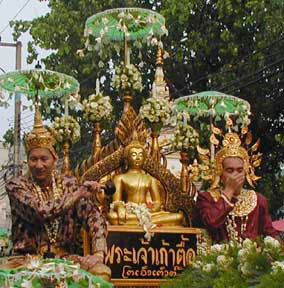 caught it, catastrophe and chaos would have been set loose to destroy the
world. If the head been thrown into the air, the world would have suffered seven years of drought. If the head had fallen into water, all the oceans would dry up for seven years. If it touched had
the ground, the fires of hell would consume the earth for seven years. ”
caught it, catastrophe and chaos would have been set loose to destroy the
world. If the head been thrown into the air, the world would have suffered seven years of drought. If the head had fallen into water, all the oceans would dry up for seven years. If it touched had
the ground, the fires of hell would consume the earth for seven years. ”
“And so, to protect the world, we will carry it up to a holy cave on Mount Krailas and place it in a stupa (a chedi where remains of the dead are buried). Each day, one of us will stand guard as protectors of the day, one of us for each of the seven days of the week. Once a year, we will take the relic on its tray and walk in procession three times around the base of Mount Krailas. Who ever is the protector of the day will lead that year’s procession and this will be the start of Songkran.”
Now each year, the chosen sister presents her own unique offering of
sacred food for the gods. Then, riding on a creature that is holy to her, hair woven 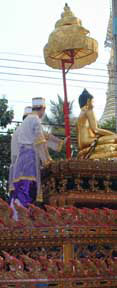 with her sacred gemstone and flowers, she leads the procession, holding her sacred symbol in her hand.
with her sacred gemstone and flowers, she leads the procession, holding her sacred symbol in her hand.
Part 4
This Brahmin story was adapted, it is believed, from earlier religions when deities were personifications of powers of the elements. Brahmin, the sun and his seven daughters, of the Seven Sisters constellation are honored for their benevolence in bringing about the rice and other crops. The New Year begins as Brahmin cedes his dominion (the hot season) to his wife, the moon, whose blessings provide moisture (the rainy season) for new crops to grow.
There is more to the story, but this is enough for now. We watch as the psycho-drama winds down. There will be two more days of this - the last day of the old year, the day in between, and the first day of the new year. The next two we will spend at home. We catch an overpriced truck taxi, take showers, and settle in for two quiet evening. Our "war" has ended!